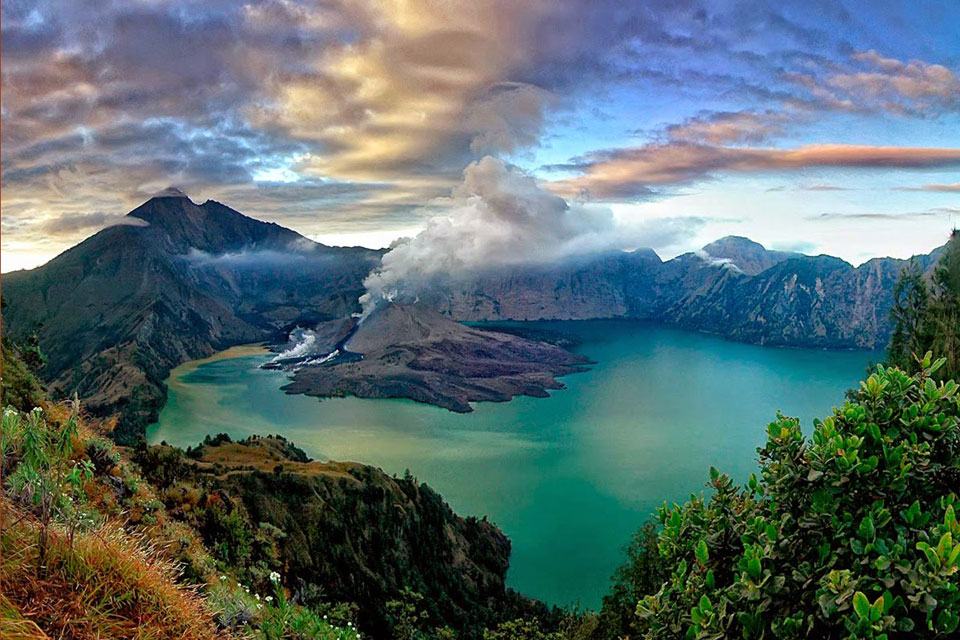Source of Mysterious Medieval Eruption from 1258 identified as Indonesia’s Samalas volcano, part of the Rinjani Volcanic Complex on Lombok Island
Around 1250 – 1300 a powerful volcano erupted somewhere on the Earth, sending the climate on a downwards spiral into the Little Ice Age, characterized through advancing glaciers, wet and cold weather and diminishing agricultural returns. Scientists have for some time sought to identify the “culprit” of “the year without summer” (1258) in order to estimate the exact magnitude of the eruption; and not least to understand the extent of the long-term consequences, which some believe may have extended as far as into the 18th century.
That a powerful volcano erupted somewhere in the world, sometime in the Middle Ages, is written in polar ice cores in the form of layers of sulfate deposits and tiny shards of volcanic glass. These cores suggest that the amount of sulfur the mystery volcano sent into the stratosphere put it firmly among the ranks of the strongest climate-perturbing eruptions of the current geological epoch, the Holocene, a period that stretches from 10,000 years ago to the present. A haze of stratospheric sulfur cools climate by reflecting solar energy back into space. But it was also early on noted in medieval chronicles. According to these the stratospheric dry fog possibly manifested itself in Europe as a persistently cloudy aspect of the sky and also through an apparently total darkening of the eclipsed Moon. Based on a sudden temperature drop for several months in England, the eruption’s initiation date can be inferred to have been around January 1258. Apparently “the frequent cold and rain that year led to severe crop damage and famine throughout much of Europe while Pestilence repeatedly broke out in 1258 and 1259; The troubled period’s wars, famines, pestilences, and earthquakes appear to have contributed in part to the rise of the European flagellant movement of 1260, one of the most bizarre social phenomena of the Middle Ages”, says Stothers in his overview of the medieval evidence.
Recently scientists have published an article identifying the medieval volcano as Indonesia’s Samalas volcano, part of the Rinjani Volcanic Complex on Lombok Island. According to the article the scientists have identified the mystery eruption of 1257 by a robust body of new evidence stemming from radiocarbon dates, tephra geochemistry, stratigraphic data and a medieval chronicle. These results solve a concudrum that has puzzled gladologists, volcanologists and dimatologists for more than 30 years.
The researchers began by reconstructing the formation of the large, 800-meter-deep caldera that now sits atop the volcano. They examined 130 outcrops on the flanks of the volcano, exposing sequences of pumice—ash hardened into rock—and other pyroclastic material. The volume of ash deposited, and the estimated height of the eruption plume (43 kilometers above sea level) put the eruption’s magnitude at a minimum of 7 on the volcanic explosivity index (which has a scale of 1 to 8)—making it one of the largest known in the Holocene. The eruption, the authors note, was on the scale of the Tambora eruption of 1815, and more powerful than Krakatoa in 1883.
The team also performed radiocarbon analyses on carbonized tree trunks and branches buried within the pyroclastic deposits to confirm the date of the eruption; it could not, they concluded, have happened before 1257 C.E., and certainly happened in the 13th century.
It’s not a total surprise that an Indonesian volcano might be the source of the eruption, Miller says. “An equatorial eruption is more consistent with the apparent climate impacts.” And, he adds, with sulfate appearing in both polar ice caps—Arctic and Antarctic—there is “a strong consensus” that this also supports an equatorial source.
Another possible candidate—both in terms of timing and geographical location—is Ecuador’s Quilotoa, estimated to have last erupted between 1147 and 1320 C.E. But when Lavigne’s team examined shards of volcanic glass from this volcano, they found that they didn’t match the chemical composition of the glass found in polar ice cores, whereas the Samalas glass is a much closer match. That, they suggest, further strengthens the case that Samalas was responsible for the medieval “year without summer” in 1258 C.E.
SOURCE:
Source of the great A.D. 1257 mystery eruption unveiled, Samalas volcano, Rinjani Volcanic Complex, Indonesia
BY Franck Lavigne et al.
In: PNAS – Proceedings of the National Academy of the United States of America 2013
(2000) Climatic and demographic consequences of the massive eruption of 1258.
By Richard B. Stothers
In: Climatic Change (200) Vol 45 (2): 361 – 374
